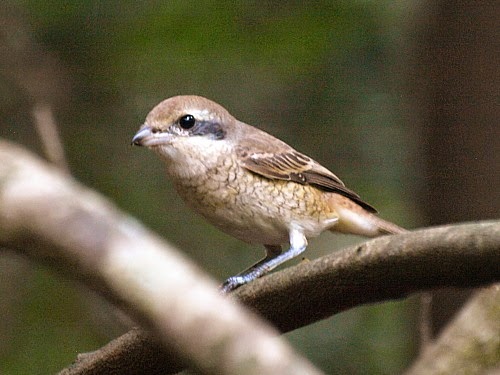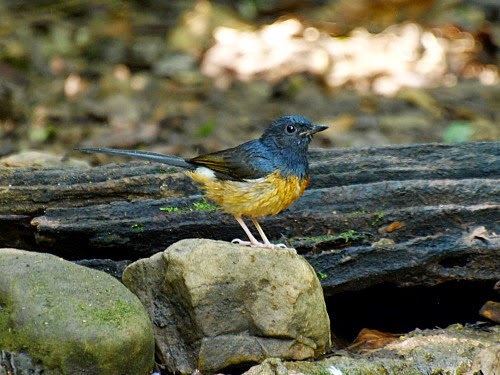In a last ditch effort to locate a Milky Stork that had been seen in the area a couple of weeks prior to our arrival we drove north to Pak Thale checking the small flocks of Storks seen en-route. On a quick check of the saltpans we failed to see any Spoon-billed Sandpipers with their favoured pan now having been completely drained. As we headed south from Pak Thale a party of four Storks were noticed in flight. One was clearly smaller and paler and our hopes were raised as they approached us. However, unfortunately some limited dark spotting was visible on its upperwing coverts quickly suggesting that this was probably a Milky x Painted Stork hybrid that has also been previously reported in the area. We returned to our accommodation and were sorry to prepare to leave this wonderful area that by now was feeling quite familiar. We departed at 8.30am and drove to Ban Maka just outside Kaeng Krachen National Park a journey that took nearly 3 hours including a couple of stops. We were greeted by a Blue-bearded Bee-eater along the entrance track and then were met by Ken, the very welcoming owner of Ban Maka, who asked if we wanted to leave immediately for a nearby area of dry forest complete with the Lung Sin photographic hide that overlooks a small drinking pool in an otherwise virtually dry stream bed. Ban Maka's highly-professional service continued throughout our stay. We followed Ken in his truck to the forest trail where he left us to spend the rest of the afternoon. Compared to what seemed a quiet forest trail the stream bed was incredibly active and produced two new birds being Bar-backed Partridge and Greater Necklaced Laughingthrush. We also saw the taxonomically-challenged Pheasant treated as a form of either Kalij or Silver Pheasant by various authorities, Scaly-breasted Partridges, Large and White-browed Scimitar-Babblers, several White-rumped Shamas and around ten Siberian Blue Robins - a species that remains one of my all-time favourite Sibes! At dusk we hoped that either a Red-legged Crake or Slaty-legged Crake might appear, but it wasn't to be. We stumbled back down the trail in the dark and saw a Large-tailed Nightjar along the dusty track as we returned to Ban Maka where a tour group from Yorkshire being lead by Games and Ian Dugdale were enjoying a meal. They kindly told us they had seen four Oriental Scops Owls the evening before in forest patches surrounding nearby fields, so we gave it a try, but unfortunately only heard one calling distantly.
BAR-BACKED PARTRIDGE 2
Scaly-breasted Partridge 2+
Red Junglefowl 12
Kalij/Silver Pheasant 2
Milky Stork hybrid 1
Painted Stork 30
Asian Openbill 30
Night Heron 2
Eastern Cattle Egret 20
Grey Heron 5
Great Egret 50
Little Egret 20
Little Cormorant 10
Brahminy Kite 1
Black-winged Stilt 50
Red-wattled Lapwing 10
Pacific Golden Plover 2
Grey Plover 1
Black-tailed Godwit 200
Curlew 50
Marsh Sandpiper 40
Greenshank 2
Wood Sandpiper 2
Sanderling 2
Red-necked Stint 50
Curlew Sandpiper 6
Brown-headed Gull 10
Gull-billed Tern 20
Caspian Tern 10
Whiskered Tern 300
Red Turtle Dove 25
Spotted Dove 10
Peaceful Dove 2
Greater Coucal 2
Asian Koel 1
Oriental Scops Owl h
Large-tailed Nightjar 1 + h
Germain's Swiftlet 50
Blue-bearded Bee-eater 1
Brown Shrike 1
Black Drongo 20
Large-billed Crow 2
Black-headed Bulbul 2
Black-crested Bulbul 1
Stripe-throated Bulbul 2
Buff-vented Bulbul 1
Streak-eared Bulbul 2
Swallow 100
Large Scimitar-Babbler 4
White-browed Scimitar-Babbler 2
Pin-striped Tit-Babbler 6
Brown-cheeked Fulvetta 10
Abbott's Babbler 8
Puff-throated Babbler 8
Lesser Necklaced Laughingthrush 6
GREATER NECKLACED LAUGHINGTHRUSH 10
White-vented Myna 100
Common Myna 2
White-rumped Shama 6
Black-naped Monarch 8
Chinese Blue Flycatcher 2
Blue-throated Blue Flycatcher 2
Tickell's Blue Flycatcher 1
Siberian Blue Robin 10
Richard's Pipit 2
Presumed Painted x Milky Stork hybrid (right)
Whilst searching for a Milky Stork that has been frequenting the area, at first glance, the small right-hand bird raised our hopes that we had hit the jackpot ...
... unfortunately close inspection of its upperwing coverts revealed some black markings were present effectively eliminating the prospect of it being a pure Milky Stork ...
... and if anything its underparts were even less appealing in that it had a partial breast band
Painted Storks near Pak Thale
Greater Coucal at the Ban Bang Resort
Arrival at Ban Maka
Chalet at Ban Maka
Female Red Junglefowl at the Lung Sin hide near Ban Maka
Male Red Junglefowls at the Lung Sin hide near Ban Maka
Male Red Junglefowl and female Kalij/Silver Pheasant L.l/n. crawfurdii
Pair of Kalij/Silver Pheasant L.l/n. crawfurdii at the Lung Sin hide near Ban Maka

Pair of Kalij/Silver Pheasant L.l/n. crawfurdii at the Lung Sin hide near Ban Maka

Male Kalij/Silver Pheasant L.l/n. crawfurdii at the Lung Sin hide near Ban Maka
The conclusions of this paper place crawfurdii within the Kalij complex:
http://www.gbwf.org/pheasants/lophuradna.pdf
Scaly-breasted Partridge at the Lung Sin hide near Ban Maka

Bar-backed Partridge at the Lung Sin hide near Ban Maka
The conclusions of this paper place crawfurdii within the Kalij complex:
http://www.gbwf.org/pheasants/lophuradna.pdf

Lesser Mouse-Deer at the Lung Sin hide near Ban Maka
Brown Shrike at the Lung Sin hide near Ban Maka
Streak-eared Bulbul at the Lung Sin hide near Ban Maka
Stripe-throated Bulbul at the Lung Sin hide near Ban Maka
Black-headed Bulbul at the Lung Sin hide near Ban Maka
Black-crested Bulbul at the Lung Sin hide near Ban Maka
Female White-rumped Shama at the Lung Sin hide near Ban Maka
Male Chinese (Blue-throated) Blue Flycatcher at the Lung Sin hide near Ban Maka
Brown Shrike at the Lung Sin hide near Ban Maka
Streak-eared Bulbul at the Lung Sin hide near Ban Maka
Black-crested Bulbul at the Lung Sin hide near Ban Maka
Immature male White-rumped Shamas at the Lung Sin hide near Ban Maka
Male White-rumped Shamas at the Lung Sin hide near Ban Maka
Female Tickell's Blue Blycatcher at the Lung Sin hide near Ban Maka
Female Blue-throated Blue Flycatcher at the Lung Sin hide near Ban Maka
Female Blue Flycatchers are difficult to identify but this individual's strongly rufescent tail, greyish forehead and its washed-out orange-rufous centre to its throat all point to this species.
Male Blue-throated Blue Flycatcher at the Lung Sin hide near Ban Maka
The blue chin, albeit restricted, appears to be diagnostic of this species.
Male Chinese (Blue-throated) Blue Flycatcher at the Lung Sin hide near Ban Maka
Chinese Blue Flycatcher C.(r.) glaucicomans is sometimes afforded full species status and is characterised by contrasting shining azure shoulder-patch and uppertail-coverts, a more azure-blue forehead/eyebrow, dark blue chin and brown flank-wash all of which this individual shows. It is also interesting to note that blue extends onto the breast sides. Perhaps its grey primaries and secondaries age it as a first-winter male?
Male Chinese (Blue-throated) Blue Flycatcher at the Lung Sin hide near Ban Maka
presumably an adult male of this form
Female Black-naped Monarch at the Lung Sin hide near Ban Maka
Male Black-naped Monarch at the Lung Sin hide near Ban Maka
Lesser Necklaced Laughingthrush at the Lung Sin hide near Ban Maka
Greater Necklaced Laughingthrush at the Lung Sin hide near Ban Maka
Squirrel at the Lung Sin hide near Ban Maka
Brown-cheeked Fulvettas at the Lung Sin hide near Ban Maka
Puff-throated Babbler at the Lung Sin hide near Ban Maka
Abbott's Babbler at the Lung Sin hide near Ban Maka
White-browed Scimitar-Babbler at the Lung Sin hide near Ban Maka
Large Scimitar-Babblers at the Lung Sin hide near Ban Maka
First-winter female Siberian Blue Robin at the Lung Sin hide near Ban Maka
First-winter male Siberian Blue Robin at the Lung Sin hide near Ban Maka
Female Siberian Blue Robin at the Lung Sin hide near Ban Maka
Male Siberian Blue Robin at the Lung Sin hide near Ban Maka













































































































